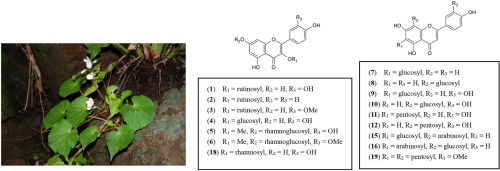当前位置:
X-MOL 学术
›
Biochem. Syst. Ecol.
›
论文详情
Our official English website, www.x-mol.net, welcomes your feedback! (Note: you will need to create a separate account there.)
Flavonoids in the leaves of Hillebrandia and Begonia species (Begoniaceae)
Biochemical Systematics and Ecology ( IF 1.6 ) Pub Date : 2020-06-01 , DOI: 10.1016/j.bse.2020.104040 Tsukasa Iwashina , Yukiko Saito , Goro Kokubugata , Ching-I. Peng
Biochemical Systematics and Ecology ( IF 1.6 ) Pub Date : 2020-06-01 , DOI: 10.1016/j.bse.2020.104040 Tsukasa Iwashina , Yukiko Saito , Goro Kokubugata , Ching-I. Peng

|
Abstract The fresh leaves of Hillebrandia sandwicensis and 126 Begonia taxa were chemotaxonomically surveyed for flavonoids. Of their taxa, H. sandwicensis and 119 species, one variety and three hybrids were analyzed for flavonoids for the first time. Ten flavonols and eleven C-glycosylflavones were isolated and characterized as quercetin 3-O-rutinoside (1), kaempferol 3-O-rutinoside (2), isorhamnetin 3-O-rutinoside (3), quercetin 3-O-glucoside (4), quercetin 3-methyl ether 7-O-rhamnosylglucoside (5), quercetin 3,3'-dimethyl ether 7-O-rhamnosylglucoside (6), quercetin glycoside (13), quercetin glycoside (acylated) (14), kaempferol glycoside (17) and quercetin 3-O-rhamnoside (18) as flavonols, and isovitexin (7), vitexin (8), isoorientin (9), orientin (10), luteolin 6-C-pentoside (11), luteolin 8-C-pentoside (12), schaftoside (15), isoschaftoside (16), chrysoeriol 6,8-di-C-pentoside (19), apigenin 6,8-di-C-arabinoside (20) and isovitexin 2''-O-glucoside (21) as C-glycosylflavones. Quercetin 3-O-rutinoside (1) alone was isolated from H. sandwicensis endemic to Hawaii. Major flavonoids of almost Begonia species was also 1. Begonia species were divided into two chemotypes, i.e. flavonol containing type and C-glycosylflavone containing type. Of 14 section of the Begonia, almost species of many section, i.e. sect. Augustia, Coelocentrum, Doratometra, Leprosae, Loasibegonia, Monopteron and Ruizoperonia, were flavonol types. On the other hand, C-glycosyflavone type was comparatively most in sect. Platycentrum.
中文翻译:

Hillebrandia 和 Begonia 物种(秋海棠科)叶子中的黄酮类化合物
摘要 对Hillebrandia sandwicensis 和126 个秋海棠鲜叶进行了类黄酮化学分类调查。首次对它们的类群 H. sandwicensis 和 119 个物种中的一个品种和三个杂种进行了黄酮类化合物分析。分离出 10 种黄酮醇和 11 种 C-糖基黄酮,并表征为槲皮素 3-O-芸香苷 (1)、山奈酚 3-O-芸香苷 (2)、异鼠李素 3-O-芸香苷 (3)、槲皮素 3-O-葡糖苷 (4) ), 槲皮素 3-甲醚 7-O-鼠李糖苷 (5), 槲皮素 3,3'-二甲醚 7-O-鼠李糖苷 (6), 槲皮素糖苷 (13), 槲皮素糖苷 (酰化) (14), 山奈酚糖苷(17) 和槲皮素 3-O-鼠李糖苷 (18) 作为黄酮醇,异牡荆素 (7)、牡荆素 (8)、异东方素 (9)、东方素 (10)、木犀草素 6-C-戊糖苷 (11)、木犀草素 8- C-戊糖苷 (12)、沙夫糖苷 (15)、isoschaftoside (16)、chrysoeriol 6,8-di-C-pentoside (19)、芹菜素 6,8-di-C-arabinoside (20) 和 isovitexin 2''-O-glucoside (21) 作为 C-糖基黄酮。从夏威夷特有的 H. sandwicensis 中单独分离出槲皮素 3-O-芸香苷 (1)。几乎海棠种的主要黄酮类化合物也为1。海棠种分为两种化学型,即含黄酮醇型和含C-糖基黄酮型。14节的海棠,几乎种了很多节,即宗派。Augustia、Coelocentrum、Doratometra、Leprosae、Loasibegonia、Monopteron 和 Ruizoperonia 是黄酮醇类型。另一方面,C-糖基黄酮类型在sect中相对最多。侧柏中心。从夏威夷特有的 H. sandwicensis 中单独分离出槲皮素 3-O-芸香苷 (1)。几乎海棠种的主要黄酮类化合物也为1。海棠种分为两种化学型,即含黄酮醇型和含C-糖基黄酮型。14节的海棠,几乎种了很多节,即宗派。Augustia、Coelocentrum、Doratometra、Leprosae、Loasibegonia、Monopteron 和 Ruizoperonia 是黄酮醇类型。另一方面,C-糖基黄酮类型在sect中相对最多。侧柏中心。从夏威夷特有的 H. sandwicensis 中单独分离出槲皮素 3-O-芸香苷 (1)。几乎海棠种的主要黄酮类化合物也为1。海棠种分为两种化学型,即含黄酮醇型和含C-糖基黄酮型。14节的海棠,几乎种了很多节,即宗派。Augustia、Coelocentrum、Doratometra、Leprosae、Loasibegonia、Monopteron 和 Ruizoperonia 是黄酮醇类型。另一方面,C-糖基黄酮类型在sect中相对最多。侧柏中心。Coelocentrum、Doratometra、Leprosae、Loasibegonia、Monopteron 和 Ruizoperonia 是黄酮醇类型。另一方面,C-糖基黄酮类型在sect中相对最多。侧柏中心。Coelocentrum、Doratometra、Leprosae、Loasibegonia、Monopteron 和 Ruizoperonia 是黄酮醇类型。另一方面,C-糖基黄酮类型在sect中相对最多。侧柏中心。
更新日期:2020-06-01
中文翻译:

Hillebrandia 和 Begonia 物种(秋海棠科)叶子中的黄酮类化合物
摘要 对Hillebrandia sandwicensis 和126 个秋海棠鲜叶进行了类黄酮化学分类调查。首次对它们的类群 H. sandwicensis 和 119 个物种中的一个品种和三个杂种进行了黄酮类化合物分析。分离出 10 种黄酮醇和 11 种 C-糖基黄酮,并表征为槲皮素 3-O-芸香苷 (1)、山奈酚 3-O-芸香苷 (2)、异鼠李素 3-O-芸香苷 (3)、槲皮素 3-O-葡糖苷 (4) ), 槲皮素 3-甲醚 7-O-鼠李糖苷 (5), 槲皮素 3,3'-二甲醚 7-O-鼠李糖苷 (6), 槲皮素糖苷 (13), 槲皮素糖苷 (酰化) (14), 山奈酚糖苷(17) 和槲皮素 3-O-鼠李糖苷 (18) 作为黄酮醇,异牡荆素 (7)、牡荆素 (8)、异东方素 (9)、东方素 (10)、木犀草素 6-C-戊糖苷 (11)、木犀草素 8- C-戊糖苷 (12)、沙夫糖苷 (15)、isoschaftoside (16)、chrysoeriol 6,8-di-C-pentoside (19)、芹菜素 6,8-di-C-arabinoside (20) 和 isovitexin 2''-O-glucoside (21) 作为 C-糖基黄酮。从夏威夷特有的 H. sandwicensis 中单独分离出槲皮素 3-O-芸香苷 (1)。几乎海棠种的主要黄酮类化合物也为1。海棠种分为两种化学型,即含黄酮醇型和含C-糖基黄酮型。14节的海棠,几乎种了很多节,即宗派。Augustia、Coelocentrum、Doratometra、Leprosae、Loasibegonia、Monopteron 和 Ruizoperonia 是黄酮醇类型。另一方面,C-糖基黄酮类型在sect中相对最多。侧柏中心。从夏威夷特有的 H. sandwicensis 中单独分离出槲皮素 3-O-芸香苷 (1)。几乎海棠种的主要黄酮类化合物也为1。海棠种分为两种化学型,即含黄酮醇型和含C-糖基黄酮型。14节的海棠,几乎种了很多节,即宗派。Augustia、Coelocentrum、Doratometra、Leprosae、Loasibegonia、Monopteron 和 Ruizoperonia 是黄酮醇类型。另一方面,C-糖基黄酮类型在sect中相对最多。侧柏中心。从夏威夷特有的 H. sandwicensis 中单独分离出槲皮素 3-O-芸香苷 (1)。几乎海棠种的主要黄酮类化合物也为1。海棠种分为两种化学型,即含黄酮醇型和含C-糖基黄酮型。14节的海棠,几乎种了很多节,即宗派。Augustia、Coelocentrum、Doratometra、Leprosae、Loasibegonia、Monopteron 和 Ruizoperonia 是黄酮醇类型。另一方面,C-糖基黄酮类型在sect中相对最多。侧柏中心。Coelocentrum、Doratometra、Leprosae、Loasibegonia、Monopteron 和 Ruizoperonia 是黄酮醇类型。另一方面,C-糖基黄酮类型在sect中相对最多。侧柏中心。Coelocentrum、Doratometra、Leprosae、Loasibegonia、Monopteron 和 Ruizoperonia 是黄酮醇类型。另一方面,C-糖基黄酮类型在sect中相对最多。侧柏中心。



























 京公网安备 11010802027423号
京公网安备 11010802027423号